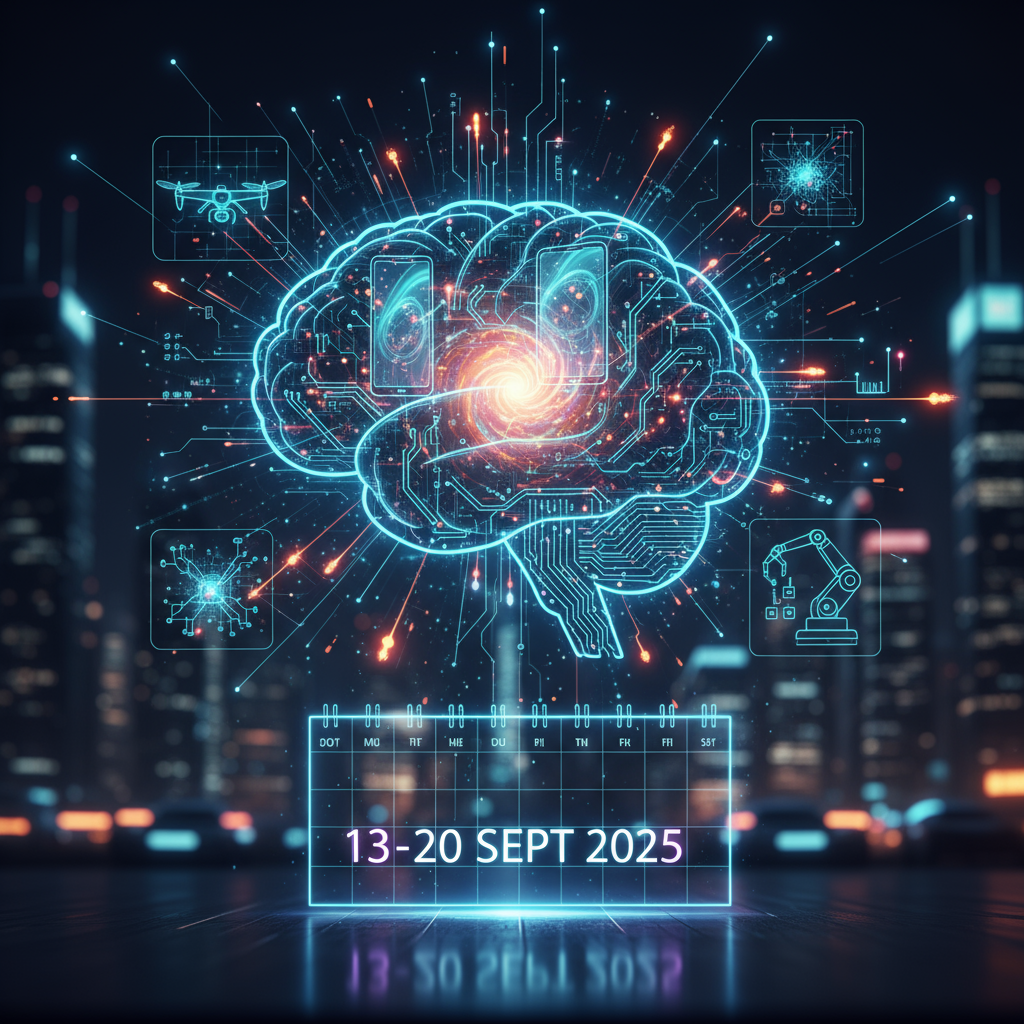A quiet hum. That’s often how innovation begins. But some weeks, that hum turns into a crescendo, a symphony of breakthroughs, regulatory shifts, and a few unexpected stumbles. The week of September 13 to September 20, 2025, was one such period, a whirlwind that underscored the relentless pace of progress and the intricate dance between technology, policy, and consumer experience.
As we dissect the events, it’s clear that the digital landscape is not merely evolving; it’s undergoing a profound metamorphosis. From the giants of software to the subtle shifts in our purchasing habits, this period offered a compelling snapshot of our interconnected future. This Weekly Tech and AI Innovations recap isn’t just about what happened; it’s about what these moments reveal about where we’re headed.
Microsoft’s Calculated Concession: Navigating the EU’s Unyielding Gaze
The week kicked off with a significant development for one of tech’s oldest titans. Microsoft, a company no stranger to antitrust scrutiny, found itself once again at the crossroads with European Union regulators. To avert a hefty antitrust fine, Microsoft agreed to unbundle its popular communication platform, Teams, from its ubiquitous Office suites. This decision, effective November 1, 2025, was a direct response to a complaint lodged by rival Slack years ago, highlighting the long arm of regulatory bodies in shaping the competitive landscape of the tech world.
For seven years, the price gap between Office packages with and without Teams had seen a substantial 50% increase. Now, Microsoft has committed to reducing prices for Office packages that exclude Teams, while setting standalone Teams pricing at required delta levels. This move isn’t just about avoiding fines; it’s a strategic realignment to comply with the EU’s mandate for a more competitive marketplace. It’s a testament to the power of regulatory oversight, demonstrating that even the largest tech companies must adjust their strategies when faced with governmental pressure. This ongoing dialogue between innovation and regulation is a critical aspect of the modern tech narrative, and understanding its nuances is key to grasping the broader shifts. For more on how large tech companies strategize, you might find our previous analysis of Microsoft’s AI strategy insightful.
The Sky’s New Sentinels: The Emergence of AI Drone Swarms
Perhaps one of the most intriguing — and potentially impactful — Weekly Tech and AI Innovations centered around the emergence of cutting-edge AI software capable of coordinating drone swarms. Imagine a flock of birds, moving in perfect, synchronized harmony; now, envision that same level of coordination applied to unmanned aerial vehicles. This new technology enables multiple drones to operate not as individual units, but as a single, cohesive force, flying and fighting as one.
This advancement represents a significant leap for both military and commercial drone applications. In defense, it promises enhanced surveillance, reconnaissance, and even combat capabilities, allowing for complex maneuvers and strategic superiority. Commercially, applications could range from highly efficient agricultural monitoring and precision delivery services to intricate infrastructure inspections. The ability for these machines to autonomously cooperate and execute complex tasks raises fascinating questions about the future of automation and the evolving role of AI in our physical world. The concept of machines making decisions and coordinating actions autonomously echoes discussions around AI agents making decisions in broader software contexts. The implications for security, privacy, and even ethical considerations are vast and will undoubtedly be a topic of intense discussion in the coming years. For further reading on military applications of AI, you can explore resources from organizations like the Center for Strategic and International Studies (CSIS).
The Silent Revolution: Used EVs Drive Mainstream Adoption
While the headlines often focus on shiny new product launches and AI breakthroughs, a quieter revolution is taking place in the automotive industry: the surging popularity of used electric vehicles (EVs). Reports from the week indicated a remarkable 40% jump in sales of used EVs in July year-over-year. This isn’t merely a statistic; it’s a powerful indicator of electric vehicle technology’s growing mainstream adoption.
For years, the high upfront cost of new EVs has been a barrier for many consumers. The robust growth in the used EV market signals that these vehicles are becoming more accessible and affordable, allowing a wider demographic to embrace sustainable transportation. This trend suggests a maturing market, where early adopters are now joined by a broader segment of the population looking for greener, more economical alternatives. It speaks to increasing battery longevity, improving infrastructure, and a growing consumer confidence in electric mobility. As these vehicles become more prevalent, their impact on urban planning, energy grids, and environmental sustainability will only continue to grow. This shift is a critical piece of the puzzle in our global push towards a more sustainable future. For detailed market analysis, reports from the International Energy Agency (IEA) offer excellent insights into global EV trends.
Google’s Pixelsnap Snafu: A Reminder of Tech’s Imperfections
Even the most innovative companies aren’t immune to missteps, and Google provided a stark reminder of this during the week. The much-anticipated debut of the Pixel 10 Pixelsnap Ring Stand, a $49 accessory, was marred by a flurry of user complaints. Reports flooded in about loose screws falling out within days, rendering the accessory unusable. But the issues didn’t stop there. Users also reported dangerous overheating when the Pixelsnap was used in conjunction with the Pixel Stand 2 wireless charger, with some phones reaching “kettle-like” temperatures during overnight charging.
This widespread problem casts a shadow over the otherwise sleek Pixel ecosystem. It highlights the intricate challenges of hardware design and manufacturing, where even small flaws can lead to significant user frustration and potential safety concerns. Google, known for its software prowess, faced a tough week in the hardware department. As of the end of the recap period, the company had not issued an official statement or recall, leaving users to scramble for solutions. In response, third-party alternatives from reputable brands like Spigen and Anker were quickly recommended by the tech community. This situation serves as a poignant reminder that even as technology advances at breakneck speed, the fundamental principles of quality control and user safety remain paramount. This is a common theme in the rapid development cycle of tech, and sometimes, even the most innovative hardware can suffer from teething problems, as we’ve noted in broader Weekly AI and Tech Recaps.
The Evolution of Expertise: AI Work Emphasizes Specialization
The narrative around Artificial Intelligence often conjures images of generalist super-intelligences. However, a significant trend emerging during this week points to a more nuanced reality: a fundamental overhaul in how AI work is structured, emphasizing specialization over generalist approaches. The industry is witnessing a shift where companies are actively restructuring their AI teams to focus on niche expertise and specialized applications.
Gone are the days when a broad understanding of AI might suffice. Today, the demand is for engineers, researchers, and developers who can dive deep into specific domains—whether it’s computer vision for autonomous vehicles, natural language processing for legal tech, or reinforcement learning for complex robotics. This focus on niche expertise allows for more efficient development, higher accuracy, and tailored solutions that can truly revolutionize specific industries. For professionals, this means a recalibration of career paths, with a premium placed on developing deep skills in particular AI subfields. It’s a clear signal that the future of work in AI is not about replacing human labor wholesale, but rather about augmenting it with highly specialized algorithmic intelligence. This trend profoundly impacts the future of work for countless individuals and industries, paving the way for roles like an AI Chief of Staff.
Gaming’s Grassroots Innovation: The Power of the Community
Amidst the grand narratives of corporate tech and AI advancements, a smaller, yet equally important, story emerged from the gaming community. A dedicated modder captured attention by significantly improving the cooling of a PlayStation console using a server-grade heatsink. This community-driven hardware improvement, shared and celebrated across online forums, highlights the ingenuity and passion that often bubble up from the grassroots level of the tech world.
Such efforts underscore that innovation isn’t solely the domain of large R&D labs. Enthusiasts, driven by curiosity and a desire to enhance their experiences, frequently push the boundaries of what’s possible, sometimes even outperforming official solutions. These “bottom-up” innovations often inspire broader industry trends and demonstrate the enduring power of collaborative problem-solving within dedicated communities. It’s a testament to the idea that some of the most practical and impactful advancements can come from unexpected places. For more examples of how communities are shaping tech, consider looking into open-source projects or specialized tech forums.
The Unfolding Tapestry of Tomorrow
This past week, from September 13 to September 20, 2025, was a microcosm of the dynamic, often unpredictable, world of technology. From regulatory battles reshaping global tech giants to the subtle yet profound shifts in how we develop and consume AI, the threads of innovation, challenge, and adaptation are continuously interwoven. We witnessed the incredible potential of coordinated AI, the growing accessibility of sustainable tech, and the persistent hurdles in hardware development. Each event, big or small, contributes to the evolving tapestry of our digital lives, pushing the boundaries of what’s possible while reminding us of the human element at its core.
What were your biggest takeaways from this packed week in tech? Did any of these stories particularly resonate with you, or perhaps challenge your perception of where technology is headed? Share your thoughts and predictions in the comments below – let’s continue the conversation!


